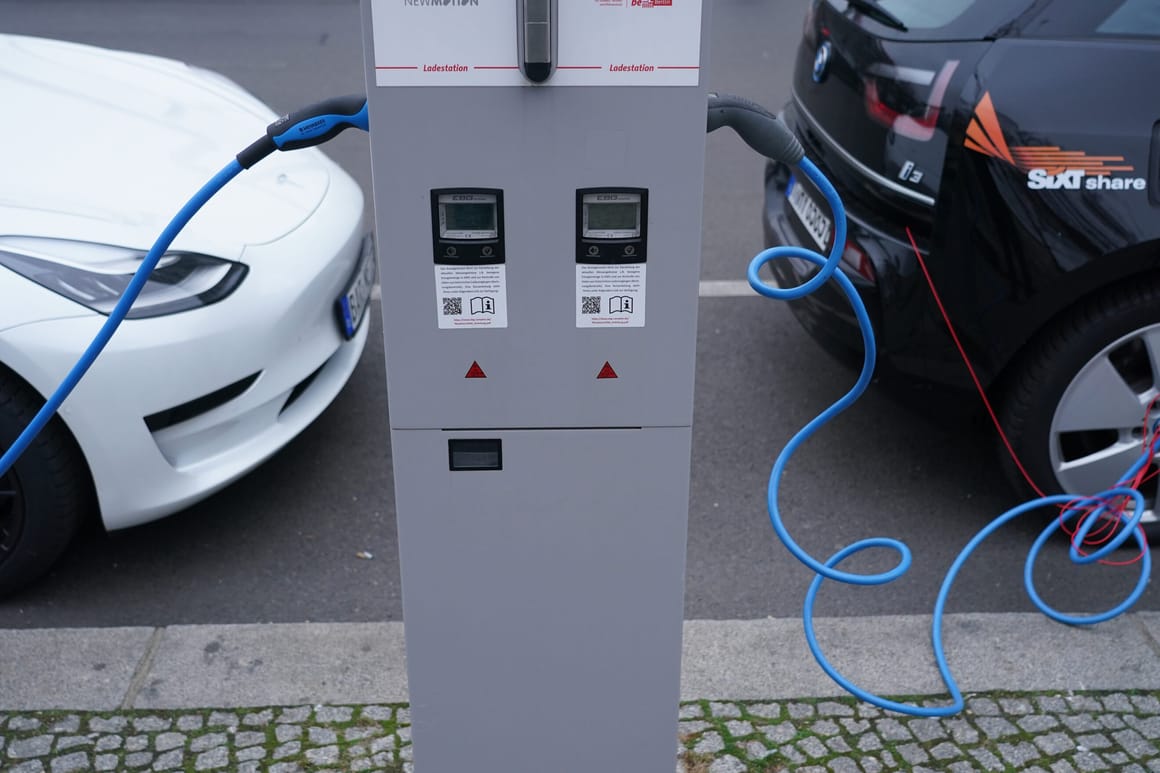Auto Industry Pushback: Dealers Resist Electric Vehicle Sales Quotas

Table of Contents
Dealership Concerns Regarding Electric Vehicle Sales Quotas
Dealerships are expressing significant concerns about the feasibility and impact of mandated electric vehicle sales quotas. These concerns stem from several key areas:
Investment Costs and Infrastructure Challenges
Meeting electric vehicle sales quotas requires substantial upfront investment. Dealerships face significant costs associated with:
- High upfront costs for EV charging infrastructure installation and maintenance: Installing and maintaining Level 2 and DC fast chargers requires considerable capital expenditure. The cost varies greatly depending on the number of chargers, location, and power requirements.
- Need for specialized training for EV sales and servicing: Sales staff needs training on EV technology, features, and benefits, while service departments require specialized technicians equipped to handle EV repairs and maintenance. This involves significant training costs and potential hiring of specialized staff.
- Uncertainty surrounding return on investment (ROI) for EV-related upgrades: Dealerships are understandably hesitant to invest heavily in infrastructure and training without a clear understanding of the long-term ROI, especially given the current uncertainties in the EV market.
- Limited availability of EV models compared to traditional vehicles, impacting inventory management: The current limited range of EV models makes it challenging for dealerships to maintain sufficient inventory to meet potential demand, increasing the pressure to sell what limited stock they have available to meet their electric vehicle sales quotas.
Dealerships argue that the mandated electric vehicle sales quotas are unrealistic without sufficient government support to offset these significant infrastructure costs.
Sales Training and Expertise Gap
The successful sale and servicing of EVs require a skilled workforce. However, a significant gap exists in terms of:
- Lack of sufficient training programs for sales staff on EV technology and features: Many sales staff lack the necessary knowledge to effectively promote and sell EVs, leading to lost sales opportunities and potentially impacting the ability to meet electric vehicle sales quotas.
- Need for specialized technicians skilled in EV repair and maintenance: Repairing and maintaining EVs requires specialized knowledge and equipment, leading to the need for training existing technicians or hiring new, qualified personnel.
- Resistance from some sales staff uncomfortable with selling a new technology: Some sales staff are hesitant to embrace new technologies, requiring additional training and support to overcome this resistance and successfully meet electric vehicle sales quotas.
Meeting the electric vehicle sales quotas necessitates a substantial investment in sales training, highlighting the pressure dealerships face.
Consumer Demand and Market Readiness
While EV adoption is increasing, several factors influence consumer acceptance and impact the ability of dealerships to meet electric vehicle sales quotas:
- Concerns about consumer acceptance and the perceived limitations of EVs (range anxiety, charging times): Range anxiety and charging time remain significant barriers for many potential EV buyers. Addressing these concerns is crucial for increasing EV adoption and alleviating pressure on dealerships to meet electric vehicle sales quotas.
- Varying levels of EV adoption across different geographic regions and demographics: Consumer demand for EVs varies considerably depending on location and demographics, making it difficult to apply uniform electric vehicle sales quotas across all dealerships.
- The need for improved charging infrastructure to alleviate range anxiety concerns: Widespread access to reliable and convenient charging infrastructure is essential to overcome range anxiety and encourage wider EV adoption, indirectly assisting dealerships in meeting electric vehicle sales quotas.
Dealerships argue that current consumer demand doesn't justify the aggressive electric vehicle sales quotas, especially without supporting public policy that incentivizes EV purchases.
Manufacturer Pressure and the Role of Government Incentives
Manufacturers are facing increased pressure to reduce emissions, leading to pressure on dealerships through aggressive electric vehicle sales quotas:
Manufacturer Mandates and Performance Metrics
Manufacturers are under pressure to comply with increasingly stringent emission regulations and targets. This is reflected in:
- Manufacturers facing strict emissions regulations and targets are pushing dealerships to sell more EVs: To meet these targets, manufacturers are imposing quotas on dealerships, linking sales performance to franchise agreements.
- Dealerships facing penalties or loss of franchise agreements if they fail to meet electric vehicle sales quotas: The pressure to meet quotas is immense, as failure can result in severe financial penalties or even loss of franchise agreements.
The pressure to meet electric vehicle sales quotas imposed by manufacturers intensifies the conflict and highlights the complexities of the transition.
Government Incentives and Their Effectiveness
Government incentives play a critical role in supporting EV adoption, but their effectiveness varies:
- Discussion of the role of government incentives in supporting EV adoption: Government incentives, such as tax credits and rebates, can significantly impact consumer purchasing decisions and incentivize dealerships to invest in EV infrastructure.
- Analysis of the effectiveness of current incentive programs for both consumers and dealerships: Evaluating the effectiveness of existing programs is crucial to understand their impact and identify areas for improvement.
- Suggestions for improvement of existing programs or new incentives targeted specifically at dealership infrastructure: Targeted incentives for dealership infrastructure upgrades could encourage investment and help dealerships meet electric vehicle sales quotas more effectively.
Government policy regarding electric vehicle sales quotas needs to account for the economic realities faced by dealerships, including providing adequate support and incentives.
Potential Solutions and Future Outlook
Addressing the conflict requires a collaborative approach and innovative solutions:
Collaborative Approaches and Industry Partnerships
Collaboration is key to smoothing the transition:
- Importance of collaboration between manufacturers, dealerships, and the government: Open communication and collaboration are essential to finding mutually beneficial solutions that address the concerns of all stakeholders.
- Exploring public-private partnerships to fund dealership infrastructure upgrades: Public-private partnerships can help alleviate the financial burden on dealerships and facilitate the necessary infrastructure development.
- Development of industry-wide training programs for EV sales and service: Standardized training programs can ensure that sales and service staff are adequately equipped to handle EVs.
A collaborative approach to manage the transition towards increased electric vehicle sales quotas is crucial to mitigate the current industry conflicts.
Phased Implementation and Flexible Quotas
A more flexible approach is needed:
- Proposing a more gradual implementation of electric vehicle sales quotas: A phased approach would allow dealerships time to adapt and invest in necessary infrastructure and training.
- Advocating for flexible quotas that consider regional variations in consumer demand: Quotas should reflect regional differences in EV adoption rates and consumer demand.
- Creating a system that rewards dealerships based on demonstrable efforts to promote EVs: Focusing on effort and investment rather than solely on sales numbers can encourage participation and innovation.
Adjusting the timeframe and approach towards electric vehicle sales quotas may improve acceptance and reduce pushback from dealerships.
Conclusion
The resistance to electric vehicle sales quotas highlights the complex challenges of transitioning to a cleaner automotive future. Addressing dealership concerns regarding investment costs, training, and consumer demand is crucial for successful EV adoption. Collaborative efforts between manufacturers, dealerships, and governments, including phased implementations and flexible quotas, are essential to navigate this transition effectively. Finding solutions that balance environmental goals with the economic realities faced by dealerships will be vital to meeting the increasing demand for electric vehicles and overcoming the current pushback against electric vehicle sales quotas. Let's work together to find sustainable solutions that support both environmental progress and the economic viability of dealerships, ensuring a smooth transition towards a future powered by electric vehicles.

Featured Posts
-
 Nba Playoffs Bucks And Pacers Game 5 Ends In Heated Altercation
May 29, 2025
Nba Playoffs Bucks And Pacers Game 5 Ends In Heated Altercation
May 29, 2025 -
 The Eurovision Song Contest 2025 Meet The Singers
May 29, 2025
The Eurovision Song Contest 2025 Meet The Singers
May 29, 2025 -
 Harry Potter Tv Series Whos Playing Dumbledore Snape Hagrid And Mc Gonagall
May 29, 2025
Harry Potter Tv Series Whos Playing Dumbledore Snape Hagrid And Mc Gonagall
May 29, 2025 -
 Queensland Music Award Winner Faces Backlash Receives Industry Support
May 29, 2025
Queensland Music Award Winner Faces Backlash Receives Industry Support
May 29, 2025 -
 Analiza Ryzyka Opoznienia I Wyzsze Koszty Flagowej Inwestycji Pcc
May 29, 2025
Analiza Ryzyka Opoznienia I Wyzsze Koszty Flagowej Inwestycji Pcc
May 29, 2025
